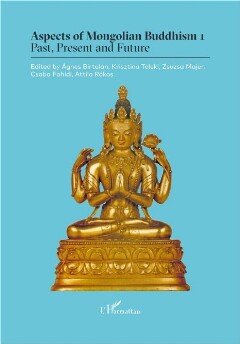Page 105 [105]
FINDING THE ÍNCARNATION OF ÖNDÖR GEGEEN
DSANABADSAR
Vladimir Uspensky
Saint Petersburg State University, Department of Asian and African Studies,
Saint Petersburg
The First Jebtsundamba Khutugtu Lubsangdanbijalsan (1635-1723; also known as
Öndör Gegeen Dsanabadsar) lived a very long life in a very turbulent period of Mon¬
golian history. He was born before the promulgation ofthe Manchu Qing Dynasty; he
entered nirvana soon after Tibet was incorporated into the Qing empire.
He was an outstanding lama-scholar, a sculptor and a politician, and he established
the most authoritative Mongolian lineage of incarnated lamas. The impetus which he
personally gave to this lineage found its culmination in the fact that the eighth incarna¬
tion became the last Mongolian Khan in 1911.
The Öndör Gegeen belonged to the Tüshiyetü Khan family and initially he seems
to have been an important lama of the Tüshiyetü Khan Aimay only. Many Mongolian
chronicles also credit to the Khutugtu the initiative to submit to the Kangxi Hdt FEB
emperor, which he put forward to the rulers of Khalkha Mongolia in 1688. This hap¬
pened in the course of the invasion into Khalkha by the army of the Jungars headed by
Galdan Boshogtu Khan. The Khalkha forces were defeated and fled to the borders of
Inner Mongolia. During his long stay in Beijing the Öndör Gegeen established good
personal relations with the Kangxi Emperor.
Among the members ofthe Tüshiyetü Khan family who were hosted in Beijing by
the Kangxi emperor for ten years was Öndör Gegeen’s nephew Dondubdorji. After
achieving a decisive victory over Galdan Boshogtu Khan in 1696, the emperor ar¬
ranged a marriage between his sixth daughter Kejing gongzhu | “ii (1679-1735)
and Dondubdorji (d. 1743).! The wedding ceremony took place in 1697, and Öndör
Gegeen participated in performing the necessary rites. This was the first time that an
emperor’s daughter was given to a Khalkha Mongol prince. A luxurious palace was
built for the newlywed in Huhe Hota.’ In 1700 Dondubdorji was promoted the title of
' A biography of Dondubdorji is found in the //dekel Sastir. See Veit, Veronika: Die vier Qane von Oalga:
Ein Beitrag zur Kenntnis der politischen Bedeutung der nordmongolischen Aristokratie in den Regierung¬
sperioden K’ang-hsi bis Ch’ien-lung (1661-1796) anhand des biographischen Handbuches Iledkel Sastir
aus dem Jahre 1795. Teil 1I: Biographien. Otto Harrassowitz, Wiesbaden 1990, pp. 57, 65.
This palace is now a museum called the “Residence of Kejing Princess of the Qing Dynasty” GB &f&
A EJF). The explanatory posters hanging inside contain rich information about the family life of
Dondubdorji and his princely wife as well as concerning the policy of the Qing dynasty towards the
Mongol with a special focus on the Manchu-Mongol intermarriages.
103

